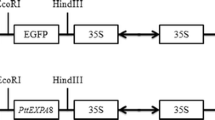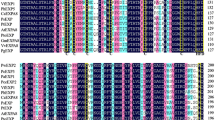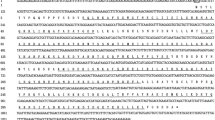Abstract
Expansin plays a crucial role in plant growth and stress resistance as a cell wall relaxation protein. The expansin family consists of four subfamilies: EXPA, EXPB, EXLA, and EXLB. However, a few reports have been previously published investigating EXLA genes. The research here aimed to characterize the PtEXLA1 gene from a popular species (P. alba × P. glandulosa CV.84K) and evaluate its role through genetic transformation to understand its contribution to plant growth and stress resistance. The results showed that the PtEXLA1 gene was 780 bp in length, encoded 259 amino acids, and had typical characteristics of EXLA. The PtEXLA1 transgenic tobacco plants had a larger corolla in comparison to wild-type plants, and exhibited higher resistance to drought, high temperature, and salt stress based on the evaluation of chlorophyll content, relative conductivity, and malondialdehyde content. PtEXLA1 can be an efficient gene resource for stress resistance breeding of plants.






Similar content being viewed by others
Data availability
All relevant data are available from the corresponding author upon reasonable request.
References
Bae JM, Kwak MS, Noh SA et al (2014) Overexpression of sweet potato expansin cDNA (IbEXP1) increases seed yield in Arabidopsis. Transgenic Res 23(4):657–667
Baker C, Mock N (1994) An improved method for monitoring cell death in cell suspension and leaf disc assays using Evans blue. Plant Cell Tissue Organ Cult 39:7–12
Boron AK, Loock BV, Suslov D et al (2015) Overexpression of AtEXLA2 alters etiolated Arabidopsis hypocotyl growth. Ann Bot 115(1):67–80
Casas-Mollano JA, Lao NT, Kavanagh TA (2006) Intron-regulated expression of suvh3, an Arabidopsis su(var)3–9 homologue. J Exp Bot 57(12):3301–3311
Chen Y, Han Y, Zhang M et al (2016) Overexpression of the wheat expansin gene TaEXPA2 improved seed production and drought tolerance in transgenic tobacco plants. PLoS ONE 11(4):e0153494
Chen S, Luo Y, Wang G et al (2020) Genome-wide identification of expansin genes in Brachypodium distachyon and functional characterization of bdexpa27. Plant Sci 296:110490
Chen GH, Wang P, Shi L (2021) Research progress on the active role of cell walls in plant disease resistance responses. J Inner Mong Agric Univ 42(05):117–120
Cosgrove DJ (2015) Plant expansins: diversity and interactions with plant cell walls. Curr Opin Plant Biol 25:162–172
Cosgrove DJ (2016) Plant cell wall extensibility: connecting plant cell growth with cell wall structure, mechanics, and the action of wall-modifying enzymes. J Exp Bot 67(2):463–476
Gupta A, Andres RM, Cao-Delgado AI (2020) The physiology of plant responses to drought. Science 368(6488):266–269
Han X, Li XY, La GX et al (2015) Identification and bioinformatics analysis of cucumber extended protein gene families. Mol Plant Breed 13(10):2280–2289
Hirsh AE, Fraser HB (2001) Protein dispensability and rate of evolution. Nature 411:1046–1049
Jiang F, Lopez A, Jeon S et al (2019) Disassembly of the fruit cell by the ripening-associated polygalacturonase and expansin influences tomato cracking. Hortic Res 6(1):17–21
Krishnamurthy P, Hong JK, Kim JA et al (2015) Genome-wide analysis of the expansin gene superfamily reveals Brassica rapa-specific evolutionary dynamics upon whole genome triplication. Mol Genet Genomics 290(2):521–530
Li H, Shi Y, Ding Y et al (2014) Bioinformatics analysis of poplar extended protein gene families. J Beijing for Univ 36(02):59–67
Liu H, Li H, Zhang H et al (2016) The expansin gene PttEXPA8 from poplar (Populus tomentosa) confers heat resistance in transgenic tobacco. Plant Cell Tissue Organ Cult 126(2):353–359
Lu PT, Kang M, Jing XQ et al (2013) RhEXPA4, a rose expansin gene, modulates leaf growth and confers drought and salt tolerance to Arabidopsis. Planta 237(6):1547–1559
Luo Y, Zhang C, Fu JX et al (2017) Identification and expression analysis of Osmanthus expansin protein gene families. J Agric Biotechnol 25(08):1289–1299
Lv J, Zheng T, Song Z et al (2022) Strawberry proteome responses to controlled hot and cold stress partly mimic post-harvest storage temperature effects on fruit quality. Front Nutr 8:812666
Malko DB, Makeev VJ, Mironov AA et al (2006) Evolution of exon–intron structure and alternative splicing in fruit flies and malarial mosquito genomes. Genome Res 16(4):505–509
Noh SA, Lee HS, Kim YS et al (2015) Expression of expansin genes in the pulp and dehiscence zone of ripening durian (Durio zibethinus) fruit. J Plant Physiol 182:33–39
Rogozin IB, Carmel L, Csuros M et al (2012) Origin and evolution of spliceosomal introns. Biol Direct 7(1):11
Sampedro J, Lee Y, Carey RE et al (2005) Use of genomic history to improve phylogeny and understanding of births and deaths in a gene family. Plant J 44:409–419
Shi Y, Xu X, Li H et al (2014) Bioinformatics analysis of the rice extended protein family. Hereditas 36(08):809–820
Stamatakis A, Hoover P, Rougemont J (2008) A rapid bootstrap algorithm for the RAxML web servers. Syst Biol 57:758–771
Virginie M, Tran PLT, Charlotte S et al (2011) G-quadruplex structures in tp53 intron 3: role in alternative splicing and in production of p53 mRNA isoforms. Carcinogenesis 32(3):271–278
Wang G, Yan G, Wang J et al (2011) Overexpression of two cambium-abundant Chinese fir (Cunninghamia lanceolata) α-expansin genes clexpa1 and clexpa2 affect growth and development in transgenic tobacco and increase the amount of cellulose in stem cell walls. Plant Biotechnol J 9(4):486–502
Wang RX, Yang RX, Yin P et al (2021) Identification and characterization of the expansin gene in Ginkgo biloba. Mol Plant Breed 19(06):1741–1749
Xu N, Gu H, Shen Y et al (2009) Effects of temperature on the changes of cell wall components in Italian ryegrass. Chin J Grassl 31(2):70–75
Yan A, Wu M, Yan L et al (2014) AtEXP2 is involved in seed germination and abiotic stress response in Arabidopsis. PLoS ONE 9(1):e85208
Yang RX, Liu XR, Lan BL et al (2021a) Identification and evaluation of the expansin genes in Salix purpurea genome. Mol Plant Breed 19(08):2538–2549
Yang RX, Yin P, Liu X et al (2021b) Expansin gene family in association with the genome differentiation of Salix matsudana. J Beijing for Univ 43(1):37–48
Yang RX, Yang LH, Wang X et al (2023) Over-expression of the Salix matsudana expansin gene SmEXPA23 enhances plant salt tolerance. Plant Cell Tissue Organ Cult 152:309–316
Yao XC, Meng LF, Zhao WL et al (2023) Changes in the morphology traits, anatomical structure of the leaves and transcriptome in Lycium barbarum L. under salt stress. Front Plant Sci 14:1090366
Zhang H, Ding Y, Zhi J et al (2018) Over-expression of the poplar expansin gene PtoEXPA12 in tobacco plants enhanced cadmium accumulation. Int J Biol Macromol 116:676–682
Zhang H, Li J, Wang RX et al (2019a) Comparative analysis of codon usage pattern of expansin genes from eight plant species. J Biomol Struct Dyn 37(4):910–917
Zhang H, Liu H, Yang R et al (2019b) Over-expression of PttEXPA8 gene showed various resistances to diverse stresses. Int J Biol Macromol 130:50–57
Zhang YQ, Zhou L, Wang Y et al (2022) Effect of temperature on the content and composition of tobacco leaf cell wall substances. Jiangsu J Agric Sci 38(01):39–48
Zhu YM (2019) The role of OfSVP transcription factors and dilated proteins in Osmanthus fragrans flowering. Master's thesis.
Acknowledgements
The research was funded by the National Natural Science Foundation of China (#31870648)
Author information
Authors and Affiliations
Corresponding author
Additional information
Publisher's Note
Springer Nature remains neutral with regard to jurisdictional claims in published maps and institutional affiliations.
Rights and permissions
Springer Nature or its licensor (e.g. a society or other partner) holds exclusive rights to this article under a publishing agreement with the author(s) or other rightsholder(s); author self-archiving of the accepted manuscript version of this article is solely governed by the terms of such publishing agreement and applicable law.
About this article
Cite this article
Liu, J., Wang, Y., Yang, L. et al. Characterization and functional analysis of the PtEXLA1 gene from poplar. Plant Biotechnol Rep 18, 119–128 (2024). https://doi.org/10.1007/s11816-023-00885-y
Received:
Revised:
Accepted:
Published:
Issue Date:
DOI: https://doi.org/10.1007/s11816-023-00885-y




